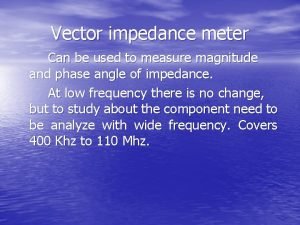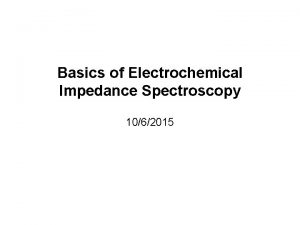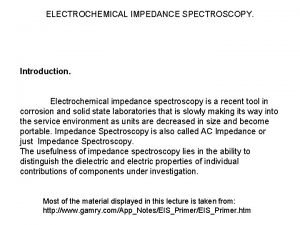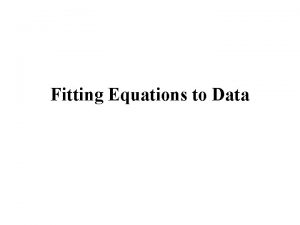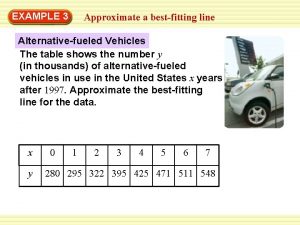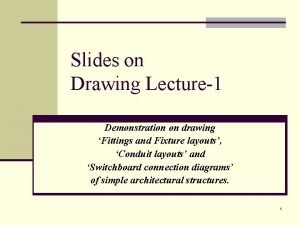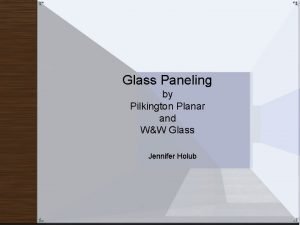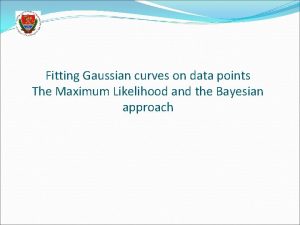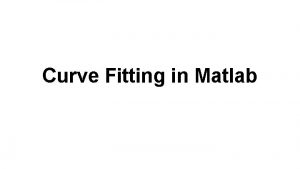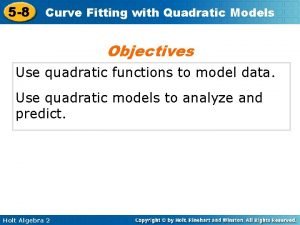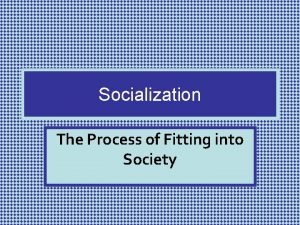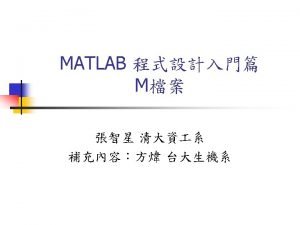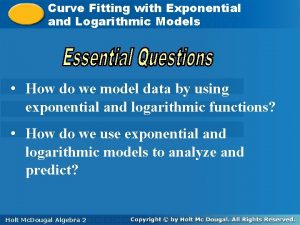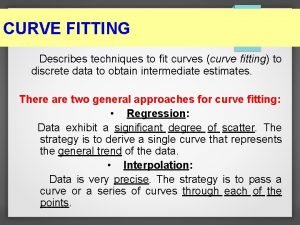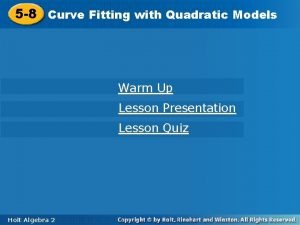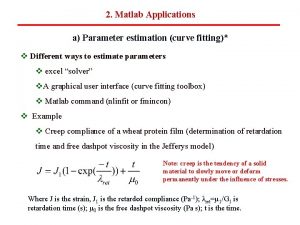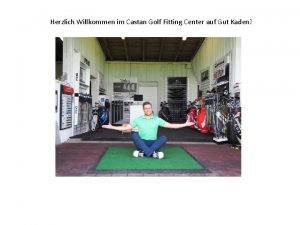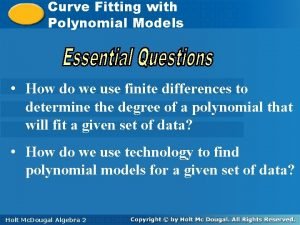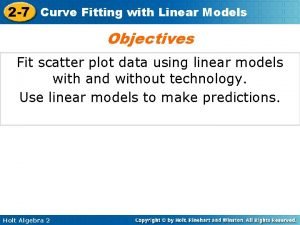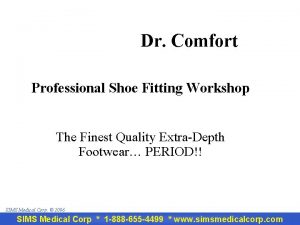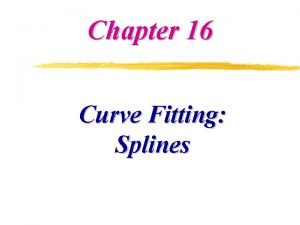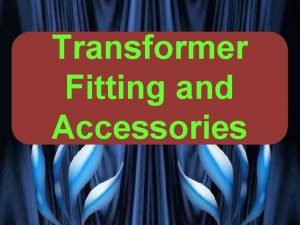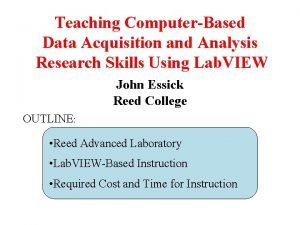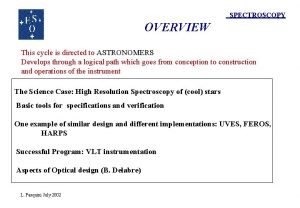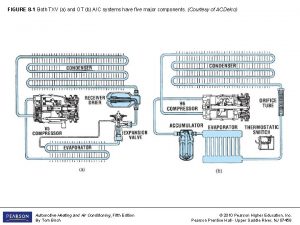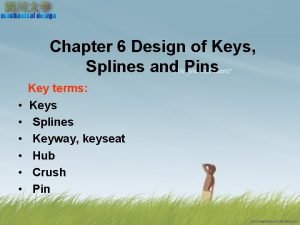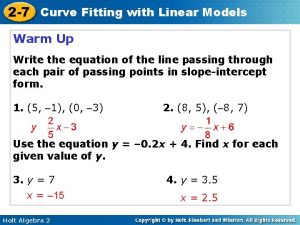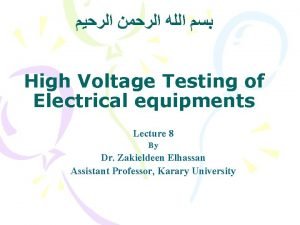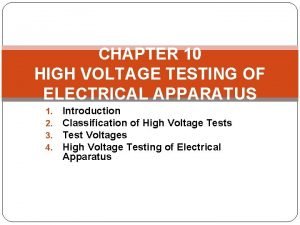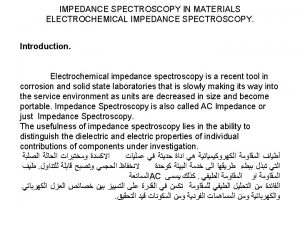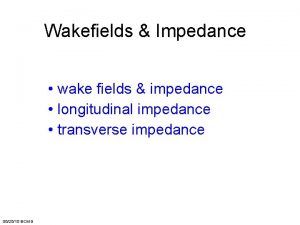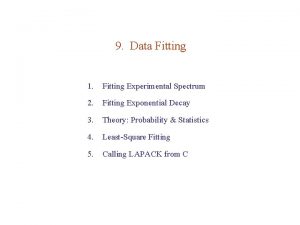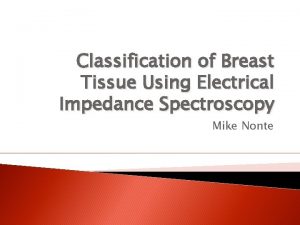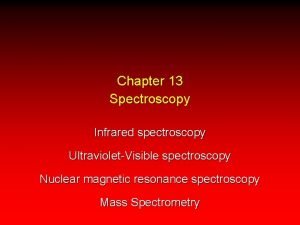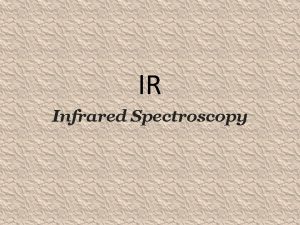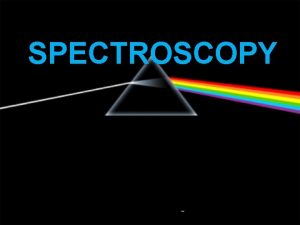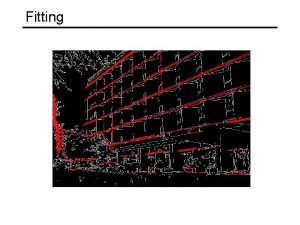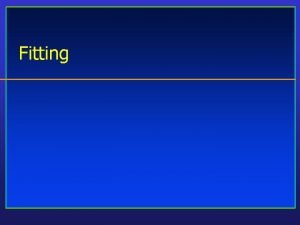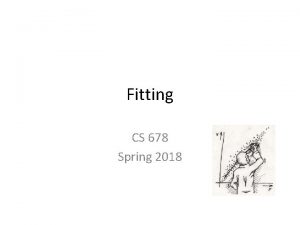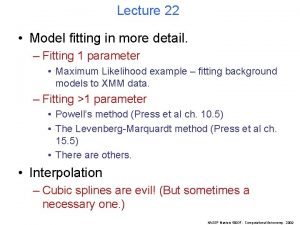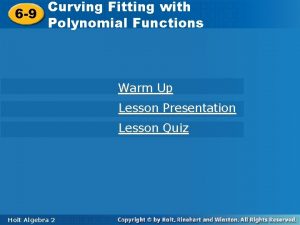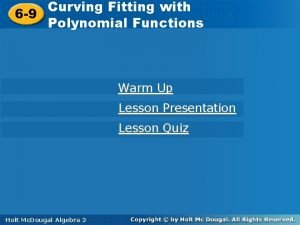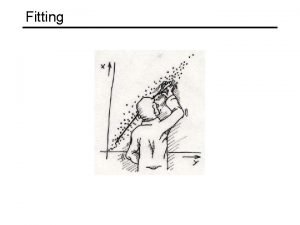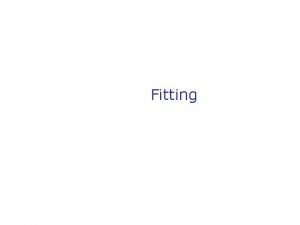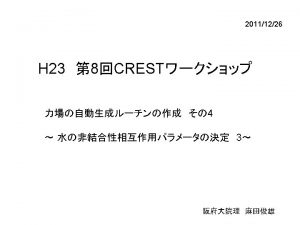FITTING HIGH IMPEDANCE DATA ELECTRICAL IMPEDANCE SPECTROSCOPY IS






























- Slides: 30

FITTING HIGH IMPEDANCE DATA • ELECTRICAL IMPEDANCE SPECTROSCOPY IS A POWERFUL TECHNIQUE TO INTERROGATE BARRIER FILMS SUCH AS ORGANIC COATINGS AND OXIDE FILMS. • HOWEVER, THE LARGE DYNAMIC RANGE (6 TO 10 ORDERS OF MAGNITUDE) PRESENT UNIQUE CHALLENGES TO NONLINEAR LEAST SQUARE (NLLS) FIT ENGINES. • CHOICE OF FIT MODEL IS PARAMOUNT TO SUCCESSFUL APPLICATION OF EIS. • THIS PRESENTATION INTRODUCES A FITTING APPLICATION THAT OVERCOMES THESE CHALLENGES. www. eishighimpedanceanalysis. com

THE PEDRA APPLICATION • PEDRA (Parallel Electrical Dielectric Response Analysis) operating under Wave Metrics IGOR PRO offers many advantages over available commercial software. • Pedra is specifically designed to fit high impedance data. • Pedra is efficient, powerful, customizable, flexible and verifiable.

PEDRA IS EFFICIENT • Everything from data import, assigning initial values, fitting convergence tools, displaying both parameters and their associated error (how well a parameter is known), graphical presentation of the fit, residuals between the fit and data and more is done on one screen. • The experimenter can easily interact with the fit routines to “walk” into fit convergence and verify the fit solution.

PEDRA IS POWERFUL • There are resources to: • • • Assign initial values based directly from the imported data Constrain parameters within a certain range Hold and release parameters Exclude data outliers Choice to display circuit parameters or physical attribute parameters Display either capacitor/thickness values or effective capacitor/thickness values; the latter which account for non-ideal behavior

PEDRA IS CUSTOMIZABLE • The program code is open source, written using IGOR PRO’s program language. • The resource tools in IGOR PRO allow program changes on the fly. • The program can be altered, immediately complied and run. • Report graphs can be edited directly on screen to change axis properties, data point and line attributes, introduce multiple axis and much more.

PEDRA IS FLEXIBLE • The number of dielectric responses resemble individual passive highpass filters, the number of which can be added or subtracted to match the complexity of the barrier film. • Parameters can be edited and held during the fit process. • Parameter constraints, effective dielectric constants, surface area, number of fit iterations, error alarm thresholds, use or release constraints can be changed as necessary during the fit.

PEDRA IS VERIFIABLE • The believability of the fit can be assessed by directly observing data point fit/line overlay, parametric and experimental error, fit residuals and ability to switch between circuit and physical display of parameters. • Physical attributes determined using PEDRA has been independently verified: • Thickness determined from EIS has been compared to independent measurements using Optical Microscopy, SEM, TEM, Eddy Current and FTIR (Fast Fourier Transform Infrared Reflective Spectroscopy (FTIR). • • Ionic Resistance paths penetrating the barrier film have been observed using TEM Power law term, n, has been correlated fractional (fractal) properties using surface AFM

PEDRA – UNIQUE FIT MODEL • PEDRA is unique by the fact that the fitting model is based on how the instrument “sees” the data as a function of applied frequency and impedance response. • This is in contrast to the more popular models, where either the empirical or physical model is based on the perception of the experimenter. • The latter perception based models significantly contribute to the amount of disagreement in interpretation between researchers and weaken the application of the technique.

MODEL – PARALLEL COMBINATION OF PASSIVE HIGH-PASS FILTERS • The EIS instrument measures the AC current response as a function of frequency. • AC current can pass through the barrier by independent current paths associated with the barrier film. • Each path has a unique cut-off frequency (time constant) • Above the cut-off frequency current is limited by the series ionic resistance. • Below the cut-off frequency current is limited by the film capacitance.

ELECTRICAL HIGH PASS FILTER https: //www. electronicstutorials. ws/filter_3. htm l

MODEL – CIRCUIT DETAILS • A parallel (independent) combination of high-pass filters can be represented as: • To accommodate non-ideal behavior a CPE is substituted for the capacitor • The number of parallel legs is dependent on the number independent responses associated with the barrier layer, which is revealed during the fit.

PEDRA DEMONSTRATION OF TEST CIRCUIT • A standard test box of electrical components containing three response legs and limiting resistance was constructed based on the fit of an 100 V anodized film on Zr-2. 5 Nb sample.

PEDRA INTERFACE • The top most tool bar contains pull down menus for IGOR PRO. • The Main Graph (left) displays the fit and has a tool bar of PEDRA pull down menus. • The Info Panel (right) displays fit results and has a tool bar at the top used to control fit operations. • At first the detail can an seem overwhelming. Let’s examine the main features using the fit to the Test Box.

IMPORT DATA • Using the File pull down menu select “Import Data”. • Several difference commercial import formats are supported. • There is also an option to load a “SIM” file, which is an Excel file with SIM in the top left with three column below: Freq, Real, Imag data.

DIELECTRIC CONSTANT AND SURFACE AREA • A dialogue box opens with the options of entering the relative dielectric constant and occulted surface area. • The option to “continue” imports and displays the data in the Main Graph.

DATA IS IMPORTED AND DISPLAYED • Three peaks are observed representing the three parallel legs of the Test Box. • Data is shown on Log(Z”Z’) axis rather than the more common phase angle Tan(Z”/Z’). • The Log(Z”/Z’) presentation clearly shows characteristics of the high-pass filter. Peaks indicate capacitance (Z”) restricting current; valleys indicate resistance passing current.

FITTING: DETERMINE INITIAL PARAMETERS • Click on the TC box for the top response, which will represent the high frequency response. • Click on the Main Graph Screen and use the key board cursor to move to the desired point. • This is always the leading edge of the observed peak, i. e. the cut-off frequency, fc. • Click the TC button again and the initial parameters are loaded into the fit routine. • Repeat the process for the other two responses

DATA IS READY TO BE FIT • The start parameters have been determined, as shown in below. • Select the “ideal” option under the Fit column. The releases R and C, and holds n values to 1. • Ignore the other information in the info panel, it will be updated as we proceed with the fit.

PROCEED WITH THE FIT • Pull down the menu under the down arrow • Select “Hold R/R” • This will hold R parameters and release only the capacitor parameters. • Hold and Releasing parameters help the NLLS routine to converge. • As values approach their fit values the other parameters can be released. • This fit iteration process prevents divergence or a false fit which will have higher experiment error than the best fit to the data.

INTERMEDIATE FIT RESULT THE MAIN GRAPH DISPLAYS LOG(Z’/Z’) VS LOG(FREQ) PRESENTATION OF THE FIT LINE TO THE DATA POINTS. THE INFO PANEL SHOWS: VALUES AND ERRORS FOR CAPACITORS, AND THAT THE RESISTER VALUES HAVE BEEN HELD.

FINAL FIT • Select “Release All” • This will release all RC parameters for the “Ideal Fit” , where “n” values are 1. • Also visible are other options to Hold and Release parameters. • Other options are necessary to fit non-ideal, more complex spectrum.

FIT RESULT FOR THE IDEAL CONDITION • The fit to the data has improved. • Blue peaks are a pseudo Gaussian construction. Peak height – thickness in nm, position – the time constant, and width the n value (the peak broadens as n decreases). • All parameter with there associate error are displayed. • Values I in square brackets “[ ]” is the percent influence the response has on the overall data. • The number in red is the Log(Time Constant

FINAL GENERAL FIT • Select General Fit, which release the power law “n” parameters. • Choose “Release all” from the fit down arrow.

FINAL FIT RESULTS • The fit line to the data points is excellent. • Thickness associated with each response is displayed above the Gaussian Constructed Peaks. • Gaussian peaks have broadened some from the idea very narrow peaks. • The normalized fit residuals are display below the Main Fit Graph • The Overall Experimental Error is displayed in the left corner below the residuals.

FINAL FIT INFO PANEL • The Info panel displays all fit results. • Each of the circuit parameters, in agreement with the test box values, are displayed. • The Power Law, n, values are all near ideal; as can be expected for electrical components. • Error associated with each parameter is reported in the column left of the values. • Percent influence of each response (brackets) • Time constants in ‘red’. • Fit Information at the bottom of the panel: • C/sin(np/2) is the effective capacitance for values on n less than 1, this corrects the units back to Farads. • Fit Constraints were “ON” • Final Experimental Error representative of instrument/setup accuracy has been normalized at Chi. Sq/number of degrees

COMPARISON TO THE 100 V ANODIC FILM HAVING SIMILAR PARAMETERS AS TEST BOX • Although the values are similar to the text box, the responses for the oxide film on Zr 2. 5 Nb are less ideal than the electrical components. • This shows up as broader Gaussian construct peaks. • Notice the residuals have a cyclic nature, rather than being random. • This is typical to non-ideal high impedance fits, that can have correlated parameters. • Finally the Experimental Error is 3% rather than 0. 5 %

COMPARISON TO THE 100 V ANODIC FILMS, CONTINUED • The values are similar to the Test Box whose values were picked based on the 100 V anodic film on Zr 2. 5 Nb. • Errors in parameters are slightly higher that the Test Box as expected under non-ideal behavior. • It was necessary to hold both n 2 and Rp to keep fit errors low. • Rp was held because it is below the constraint of 1 e 10. • n 2 is correlated to n 3, when it is not held the error is very high. This is an indication of correlated parameter; whose topic is beyond the scope of this presentation

• • REMOVED PT AFTER 15 YEARS OF SERVICE As an example of capability of the EIS technique, the spectrum from a Pressure Tube from a CANDU Nuclear Power Reactor. Measurement was made in a radioactive environment within a Hot Cell leads were 6 metres long connecting the specimen to the instrument outside the Hot Cell. The surface was only wiped with a rag prior to measurement. The overall oxide thickness was about greater than 20 microns, measured by metallography. The barrier layer beneath the outer porous oxide is about 0. 6 microns. The lower frequency responses 2 and 3 are interior features allowing penetration. The similarity between the thicknesses indicates that the barrier oxide is not

REMOVED PT AFTER 15 YEARS OF SERVICE, CONT. • Fit results in the Info Panel. • Thickness (in nm) rather than circuit values and fractional distribution (Df) rather than power law (n). • Thickness was calculated using a relative dielectric constant interpedently determined previously. • Once again a n 3 (Df 3) needed to be held after the fit, due to correlated parameters, to display true errors in parameters. • Surprisingly, the experimental error is only 1. 5% • Responses 1 and 2 contribute most to the collected data, where as response 3 had only a 8% influence. (This is also indicated by only a bump in the fit line, rather than a peak, at low frequency. • This kind of barrier film detail is not possible, without much more time consuming, extensive and costly experimental methods.

FINAL COMMENTS • THIS PRESENTATION DEMONSTRATES THE POWER, VERSATILITY AND CAPABILITY OF BOTH THE EIS TECHNIQUE AND THE PEDRA ANALYSIS APPLICATION. • THE HIGH PASS FILTER CIRCUIT IS BOTH CAPABLE AND APPROPRIATE TO FIT HIGH IMPEDANCE DIELECTRIC DATA ASSOCIATED WITH COATINGS AND OXIDES. • PEDRA PROVIDES THE EXPERIMENTER WITH AN EFFICIENT, POWERFUL, CUSTOMIZABLE, FLEXIBLE AND VERIFIABLE TOOL TO ANALYZE HIGH IMPEDANCE DATA. • THIS CAPABILITY HAS BEEN DEMONSTRATED FOR: • • • Near-ideal electrical circuits components Well controlled laboratory measurements on anodized films Remote measurement in a harsh environment, with little surface preparation, and after long exposure in an commercial application. • • CONCLUSIONS: • PEDRA IS CAPABLE OF MEETING THE CHALLENGES IN FITTING HIGH IMPEDANCE DATA. THE EIS TECHNIQUE DELIVERS DETAILS OF BARRIER FILM, NOT POSSIBLE WITH OTHER TECHNIQUES. www. eishighimpedanceanalysis. com
 Vector impedance meter
Vector impedance meter Electrochemical impedance spectroscopy
Electrochemical impedance spectroscopy Electrochemical impedance spectroscopy
Electrochemical impedance spectroscopy Fitting equations to data
Fitting equations to data How to approximate the best fitting line for data
How to approximate the best fitting line for data Conduit layout drawing
Conduit layout drawing Pilkington planar
Pilkington planar Gaussian curve fitting
Gaussian curve fitting Curve fitting matlab
Curve fitting matlab Quadratic curve fitting
Quadratic curve fitting Fitting into society
Fitting into society Matlab
Matlab Logarithmic curve fitting
Logarithmic curve fitting Curve fitting techniques
Curve fitting techniques Curve fitting with quadratic models
Curve fitting with quadratic models Parameter estimation matlab
Parameter estimation matlab Castan golf
Castan golf Curve fitting with polynomial models
Curve fitting with polynomial models Curve fitting with linear models
Curve fitting with linear models Dr comfort order forms
Dr comfort order forms Loose-fitting clothing
Loose-fitting clothing Quadratic spline interpolation matlab
Quadratic spline interpolation matlab Transformer fittings and accessories
Transformer fittings and accessories Labview curve fitting
Labview curve fitting Main sequence fitting
Main sequence fitting A/c fitting size chart
A/c fitting size chart Steer clipping and fitting techniques
Steer clipping and fitting techniques Keys and splines
Keys and splines Curve fitting with linear models
Curve fitting with linear models High voltage testing of electrical apparatus
High voltage testing of electrical apparatus High voltage testing of electrical apparatus
High voltage testing of electrical apparatus
